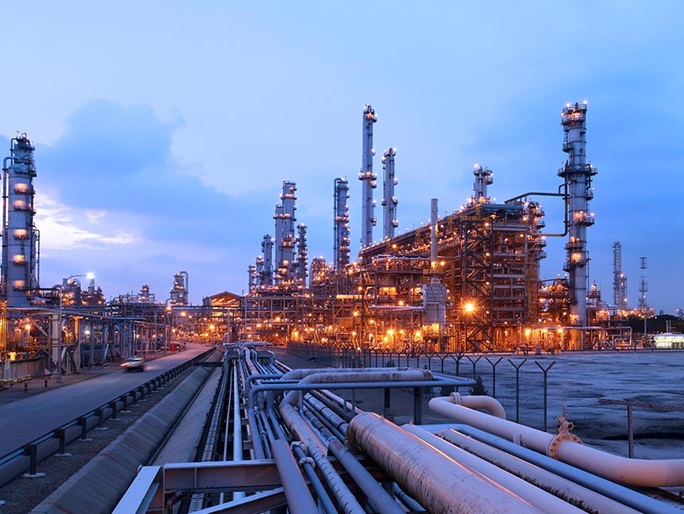
Petrochemical
Petrochemical, in the strictest sense, any of a large group of chemicals (as distinct from fuels) derived from petroleum and natural gas and used for a variety of commercial purposes. The definition, however, has been broadened to include the whole range of aliphatic, aromatic, and naphthenic organic chemicals, as well as carbon black and such inorganic materials as sulfur and ammonia. In many instances, a specific chemical included among the petrochemicals may also be obtained from other sources, such as coal, coke, or vegetable products. For example, materials such as benzene and naphthalene can be made from either petroleum or coal, while ethyl alcohol may be of petrochemical or vegetable origin. This makes it difficult to categorize a specific substance as, strictly speaking, petrochemical or nonpetrochemical.
Products made from petrochemicals include such items as plastics, soaps and detergents, solvents, drugs, fertilizers, pesticides, explosives, synthetic fibres and rubbers, paints, epoxy resins, and flooring and insulating materials. Petrochemicals are found in products as diverse as aspirin, luggage, boats, automobiles, aircraft, polyester clothes, and recording discs and tapes. For example, crude oil and natural gas, petrochemicals are composed primarily of carbon and hydrogenand are called hydrocarbons. If, in the molecules, the carbon atoms are linked by single bonds, the molecules are said to be saturated. If they are linked by one or more double bonds, the molecules are said to be unsaturated. Unsaturated chemicals are preferred as petrochemical feedstocks because they are more chemically reactive and can more easily be changed into other petrochemicals.
The various components of petroleum used as raw materials in the production of other chemicals are known as feedstocks. Petrochemical feedstocks can be classified into three general groups: olefins, aromatics, and a third group that includes synthesis gas and inorganics. Olefins, whose molecules form straight chains and are unsaturated, include ethylene, propylene, and butadiene. Ethylene is the hydrocarbon feedstock used in greatest volume in the petrochemical industry. From ethylene, for example, are manufactured ethylene glycol, used in polyester fibres and resins and in antifreezes; ethyl alcohol, a solvent and chemical reagent; polyethylene, used in film and plastics; styrene, used in resins, synthetic rubber, plastics, and polyesters; and ethylene dichloride, for vinyl chloride, used in plastics and fibres. Propylene is used in making such products as acrylics, rubbing alcohol, epoxy glue, and carpets. Butadiene is used in making synthetic rubber, carpet fibres, paper coatings, and plastic pipes.

Gas
Gas, one of the three fundamental states of matter, with distinctly different properties from the liquid and solid states.The atmosphere surrounding the earth is a gas too. Helium, Oxygen, Carbon dioxide and water vapour are all gases.
The particles in gases are very different from that of solids and liquids.
In gases, the particles are far apart from each other and arranged in a random way. The particles also move quickly in all directions. Gases can fill up any container of any shape and size. Gases can be compressed or squashed because the molecules are far from each other. When gas is compressed, the gas molecules move from an area of high pressure to low pressure.
10 Everyday Products Derived from Petroleum
When crude oil or natural gas is processed at a refinery, it is converted into numerous petroleum products. In 2017, 75% of oil was processed into motor gasoline, distillate fuel and jet fuel but the remainder was processed into chemicals, synthetic rubber and a variety of plastics used to manufacture our creature comforts. Below is a list of common products you might be surprised to learn are derived from petroleum hydrocarbons.
Aspirin, one of the most common medications used to treat pain, inflammation and fevers, consists of benzene, a hydrocarbon typically derived from petroleum.
As most plastics made from petrochemicals, CDs and DVDs are made from polycarbonate plastics. When compact discs were created, petroleum-based lubricants were needed to made the disk spin smoothly.
The base of chewing gum is manufactured with petroleum wax. The Food and Drug Administration approves the use of this substance as long as it meets particular ultraviolet absorbance limits. You may also find paraffin wax in your kitchen or pantry as it is used to coat cheese, raw fruits and vegetables, in chicken nuggets to prevent foaming during preparation, and in over-the-counter drugs to prevent bloating.
Unless you make it a point to wear only 100% wool or cotton, you most likely have a dresser full of polyester clothing. Polyester is a synthetic petroleum fiber incorporated into 60% of clothing worldwide. Unlike cotton products, polyester is not biodegradable.
Today’s dentures are made with acrylic resin, a hydrocarbon, along with porcelain, metal and nylon. The acrylic resin can be dyed to look more like natural gum color.
Some cosmetics, including lipstick, are made with paraffin wax, the same synthetic wax used for chewing gum and scented candles.
Any rugs made with synthetic fibers use petroleum based nylon or olefin. Some rugs have blended fibers, mixed with both synthetic and natural fibers like animal wool, cotton, and even plant cellulose.
So-called dry shampoo uses liquified petroleum gas to spray the cosmetic into dry hair. Also known as LPG, propane and butane is considered liquified petroleum gas. Another thing to keep in mind: the whole plastic shampoo bottle is produced from petrochemicals derived from the oil refinery process. Most plastics, including water bottles are a part of this process.
Fossil fuels are used in the manufacturing of solar panels but are also found in the solar cell parts that help convert sunlight into electrical energy. However, as the Scientific American reports, those synthetic petroleum-derived plastics may soon be replaced by plant-based fiber components.
Toothpaste uses poloxamer 407, a common petroleum derivative that helps oil-based ingredients to be dissolved in water.
Iran Petrochemicals Overview
Due to the rich oil and gas reserves, Iran petrochemical industry is considered as one of the forerunner sector and has grown dramatically in the past two decades, yet it has not reached its real status. The industry plays a leading role in non-oil export, economic prosperity, sustainable development, technology localization, downstream industries, employment and so on.
Petrochemical industry along with the completion of value added chain in case of optimal use of capacities, can increase GDP, employment, Iran’s position as a powerful exporting country and create a permanent consumption market for upstream large industries. Given the world limited hydrocarbon reserves and the formulation of macro policies to maximize the use of fossil fuels and create value added, the petrochemical industry is now becoming one of the most strategic industries in the world.
With 33 TCM of conventional natural gas and 158 bn barrels of oil-extracted reserves, Iran has a great advantage in developing the petrochemicals, oil and gas value to prevent crude retailing in order to gain higher value added via petrochemical products export. Iran’s share of the 3,700 bn USD turnover of petrochemicals in the world is less than 1%. With largest gas reserves, Iran has the main sources of feed for petrochemical complexes.



